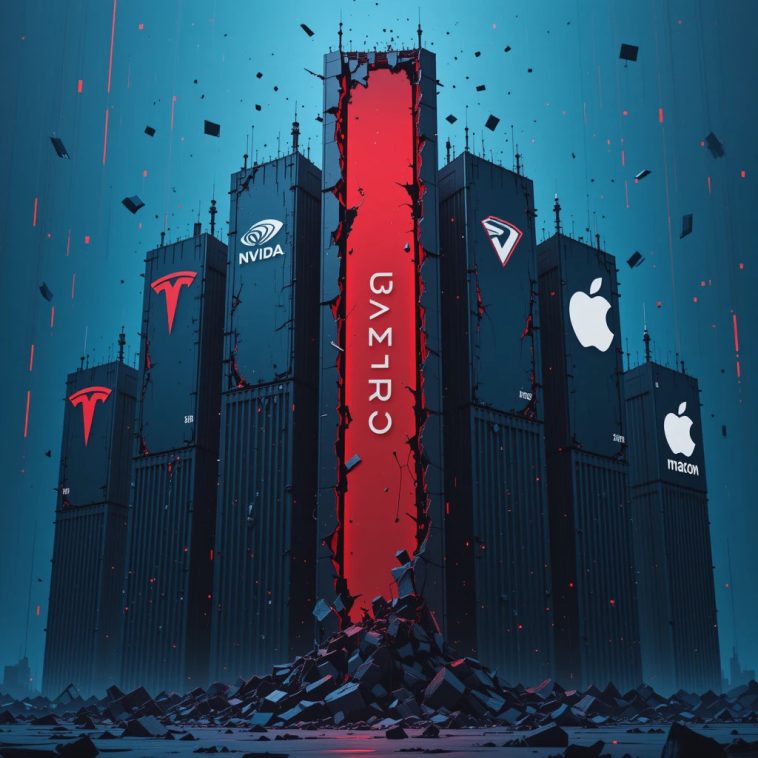The “Magnificent 7” stocks experienced a brutal first quarter in 2025, leaving investors wondering whether it’s time to buy the dip after this significant sell-off. The Bloomberg Magnificent Seven Index plummeted 16% in Q1, wiping out approximately $2.4 trillion in market capitalization, substantially underperforming broader market indices.
Understanding the Magnificent 7 Stocks Sell-Off
The Magnificent 7 stocks sell-off has caught many investors by surprise given their previous market dominance. “Probably what’s been happening is they feel heavy — there’s so much gains in them and not a lot of new buyers who don’t understand the story and had already participated,” explained Truist co-chief investment officer Keith Lerner in an interview with Yahoo Finance. “Also a big concern right now is that tech is overspending.”
This widespread Magnificent 7 stocks sell-off resulted in significant losses across the group. Tesla (TSLA) performed worst, dropping 36% during the quarter. Nvidia (NVDA) fell 17%, while Alphabet (GOOG) declined 18%. Amazon (AMZN) lost 14%, Microsoft (MSFT) dropped 11%, and Apple (AAPL) decreased by 9%. Even Meta (META), which initially outperformed the S&P 500 with a 26% gain between January and February, eventually finished the quarter down 6%.
Company-Specific Factors Behind the Magnificent 7 Stocks Decline
Several individual factors contributed to the Magnificent 7 stocks sell-off:
- Tesla’s CEO Elon Musk faced criticism for his work with the Trump administration, while global sales declined dramatically, prompting Wall Street analysts to become more cautious about the company’s financial outlook for 2025.
- Nvidia failed to meet high expectations at its annual GTC event in March, with analyst profit estimates remaining largely unchanged afterward.
- Apple shares suffered from fears of Trump tariffs, as the company manufactures most of its products in China.
- Both Microsoft and Amazon reported slowing cloud growth in their Q4 earnings, with profit margins coming in below some analyst expectations.
What’s Needed to Revive the Magnificent 7 Stocks Trade?
For the Magnificent 7 stocks to regain their market leadership, several key developments need to occur. According to Lerner, “I think it can be just some time passing where earnings continue to rise, which they are today, while prices consolidate, and investors realize they [the stocks] are cheap again on a relative basis to growth prospects.”
Investors would also welcome evidence that AI-related spending concerns are overblown. If companies began to implement cost-cutting measures, this could help alleviate worries about profit margins within the Magnificent 7 stocks group.
Despite the current Magnificent 7 stocks sell-off, some market experts remain optimistic. “NVDA, [AAPL], AMZN, MSFT — all names I own… and I like them especially after the pullback. None of these companies are going anywhere,” said Kace Capital Advisors managing partner Kenny Polcari.
AI Demand Could Reignite Magnificent 7 Stocks Performance
A key catalyst for reviving the Magnificent 7 stocks could be confirmation that demand for artificial intelligence computing remains robust. AMD CEO Lisa Su emphasized this point in a recent interview: “The need for compute continues to be immense. We see that throughout all of our customers globally, and we’re going to continue to invest strongly in this area because I think this is the single most important technology. I like to say it’s the single most important technology of the last 50 years.”
If upcoming earnings reports and guidance from the Magnificent 7 stocks demonstrate continued strength in AI adoption and implementation, investor confidence could quickly return to these market leaders despite their recent performance struggles.



